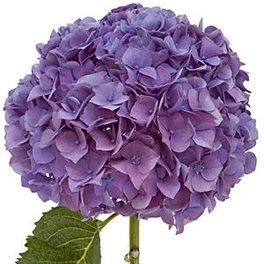![]() Prices in Canadian Dollars.
Prices in Canadian Dollars.![]() Prefer to call and speak to a floral agent? 1-877-277-4787
Prefer to call and speak to a floral agent? 1-877-277-4787
Hydrangea
Hydrangea
The Hydrangea (“Hortensia” in Spanish) is a genus of about 75 species of flowering plants native to eastern Asia as well as both North and South America.

Remarkably, the Hydrangea can change its color on its own from blue to pink and pink to blue naturally induced by the environment or by the grower. The colour can be altered based upon the Ph level of the soil. Soils with a higher level of acidity(lower pH) produce Hydrangeas that are blue, while neutral soils(mid-range pH) produce very pale, ivory petals. Alkaline(higher pH) soils generally produce flowers that are pink or purple. Growers need to be sure about when and how to do it or they will get problematic colors, sometimes referred to as “blurple” tones.
The pink hydrangea has grown in popularity all over the world, but no more so than in Asia. Pink hydrangeas have many different meanings, but the most accepted is , “You are the beat of my heart”, as described by the celebrated Asian florist Tan Jun Yong, when he stated, “The light delicate blush of the petals reminds me of a beating heart, while the size could only match the heart of the sender!”
Hydrangeas grow best in moist, well-drained soil. Most hydrangeas benefit from some shade, especially in hot climates. Bigleaf, oakleaf and smooth hydrangeas will usually perform well on the north side of a house or planted at the edge of a woodland. Growing hydrangeas in deep shade is not necessary and can greatly reduce flowering. Planting your hydrangeas in early spring or in the fall is ideal. When you are planting a hydrangea, remember that the blooms and stems must be protected from strong winds and the hot afternoon sun. Avoid planting in open areas where strong winds could break stems. Ensure your plant has good drainage, as if the soil is too wet, the roots may rot resulting in the death of the plant. Always incorporate a good deal of organic matter and an all-purpose slow-release fertilizer into the soil to give your hydrangea a good strong head start.
Care & Handling:
- In the garden hydrangeas do not have to be pruned back ever, unless they are really getting on in age. Removing dead stems is the only pruning that must be done for the health of the plant, and these can be removed at any time. Dead blooms can also be removed at any time.
- When a plant is young it is suggested that you pinch it in order to build a full bodied, well branched plant. If the plant is leggy when you purchased it, shear the plant back hard by 1/3 to 1/2 its original size. After it gains an inch or two of growth, pinch the branch tips to remove just the growing tip, as this will control branching. Once it is removed the buds below it will turn into stems. Once these new branches grow an inch or two, pinch the tip out again. You can repeat this throughout the first growing season and although you may sacrifice one year of bloom, this technique results in a well branched, full bodied plant that will have more flowers in subsequent years. The second season in the ground, repeat the pinching practice (or lightly shear). Cease pruning and pinching to allow the flower buds to set.
- Hydrangeas are popular ornamental plants, grown for their large flower heads, with Hydrangea macrophylla being by far the most widely grown with over 600 named cultivars, many selected to have only large sterile flowers in the flowerheads.
Design Suggestions:
In today’s flower market, Hydrangeas have become very special in wedding work. The massed, spherical form and supple texture of Hydrangea blooms makes them a preferred choice in upscale floral arrangements. Bouquets and arrangements. They should be prepared as close as possible to the actual ceremony and kept refrigerated and hydrated until ready for use.

